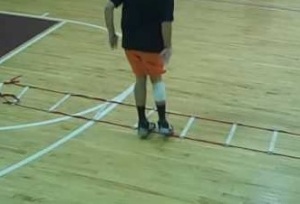 Since basketball is a game where the action that we focus on takes place with the hands, it is an easy thing to overlook the importance of footwork. Good footwork on defense helps players stay on balance, play in better position, and avoid fouling. On offense, good footwork helps in positioning, faking, and reducing turnovers. This article will offer a few ideas for some fundamental basketball footwork drills to improve your players.
Since basketball is a game where the action that we focus on takes place with the hands, it is an easy thing to overlook the importance of footwork. Good footwork on defense helps players stay on balance, play in better position, and avoid fouling. On offense, good footwork helps in positioning, faking, and reducing turnovers. This article will offer a few ideas for some fundamental basketball footwork drills to improve your players.
Starts, stops, and pivots footwork drill
This is a great drill to work on being on balance to avoid traveling and fumbling the basketball. You can do this drill with or without a basketball, depending on the age and ability of the players that you coach.
Players start on the baseline, facing half court. When coach says “right foot, go!” players step with their right foot, concentrate on keeping their left foot still and either dribble the ball if they have one, or pretend dribble if they are younger and are doing the drill without a basketball.
They dribble for about 15 feet and make a jump stop. Use the free throw line and free throw line extended to guide you. Now, have the players pivot using forward and reverse pivots to protect the basketball. On your whistle, have them pivot and face back toward the baseline.
Now, they must know which foot to move—the one that they were pivoting with when you say “go” for them to dribble back to the baseline. Continue the drill, alternating which starting foot you use. Emphasize correct footwork, stance, and not traveling. This is a good drill to use at the beginning of your season and then from time to time to keep players sharp throughout the season.
Cut, catch, create offensive footwork drill
This is a good drill to use for a couple of minutes prior to your shooting drills. Position players in spots where they will be in your offensive system. You can either have players make cuts with or without screens. Have them go half speed to get their footwork right.
They should take their defender away from where they are going to cut and cut off the screen going shoulder to shoulder with the screener. The next step is to work on whatever footwork you teach on the catch, two foot stop, or one two into the shot. After the catch, the player works on the footwork for a shot fake. Player makes a start without traveling and then drives to the basket to work on the footwork of finishing at in the lane.
Each time you do this drill, put players in different spots on the floor where they make cuts within your offensive system.
Mass stance defensive footwork drills
These are good drills to simulate the footwork involved in various defensive responsibilities. In each version of the drill, start out slow so that players can think through the movements and get a feel for the footwork involved. Gradually increase the pace of the drill until you have the players going at game speed.
This example is to work with players in their on-ball defensive stance. Players are spread around the half court in a defensive stance. Coach yells “fire” and players pitter patter their feet. When the coach points left, players slide left. Same with sliding right, sliding forward, and sliding backward. Players should keep their feet as wide as possible and still be able to move.
You can develop similar drills to work on the footwork that you teach for denying a player the ball, getting through screens, and closing out on the basketball.
Footwork drills are not players’ favorite thing to do. It is hard to make them competitive and they are repetitive. This is where the art of coaching comes in by explaining the value of footwork drills and soliciting buy in from your players. Convincing them that proper footwork will save them a foul or two and a turnover or two each game is a good place to start.
If you get five players to make those improvements for each game, it is easy to see that basketball footwork drills can make a significant difference in your win/loss record.